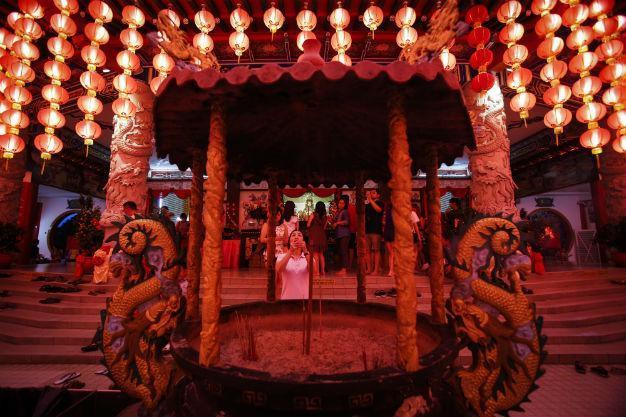Year of the fiery Monkey
Aylin Öney Tan - aylinoneytan@yahoo.com

AP photo
Today is the start of the Chinese New Year, which happens to be a Monkey year. According to the 12-year cycle of animals in the Chinese zodiac, the Year of the Monkey occupies the ninth place, this one being the year of the Red Fire Monkey. The cycle not only depends on animals, but also on the five elements of wood, fire, earth, metal and water. Both fire and red stands for energy; aggressiveness is another property of the color red. Can we say that it will be a fiery year?The word “zodiac” has roots in the Chinese calendar based on a twelve-year cycle of animals. The same pattern is seen in old Turkish traditions, long before the Turks started their westward exodus from Central Asia. Turkic tradition worships nature and shamanistic beliefs are still seen in our daily superstitions. One thing long forgotten is the Turkic animal calendar, which is identical to the Chinese animal calendar. Zodiac practically means “circle of animals,” pretty much like a zoo, a garden of zoology. The old Turkic calendar is based on twelve animals, each year represented by another animal character, and according to some scholars, it had a mutual influence on the Chinese calendar, via Mongolian, Kirgiz and Uighur connections.
There are even some scholars that the Chinese calendar is Uighur in origin, but most sinologists tend to disregard this possibility. One thing is certain: Turks were obsessed with the sky, and their primary deity was of the God of Sky, or “Gök Tanrı.” It was the “Gök Kubbe,” the “Sky Dome,” that lead them in finding their path, both in the sense of a way, as stars are telltale of direction, and in a spiritual manner. The bright blue of the sky is another obsession of Turks. That’s why many of monuments in Central Asia have their domes covered in turquoise tiles. The reason for this turquoise infatuation lies in the Turkish obsession with the crisp blue of clear skies, which felt so much nearer on the Anatolian plateaus, just like their homeland of the Asian-landlocked high lands. With their heads up in the sky, keen on watching every movement of the sun, the moon and the stars, it is very likely that the Turks arranged their life according to what is happening up in the sky.
Coming back to monkey, it is the most playful animal in the whole lot of twelve, even mischievous many times. One characteristic of monkeys is that they are very similar to humans in behavior. Both share an insatiable quest for curiosity, usually getting them in trouble (This is even more true for humans.) The monkey zodiac in Chinese is “Shēngxiào,” literally meaning “birth likeness.” We must not forget that one step back from the Homo genus is CHLCA, the last common ancestor of chimpanzees and humans, which is also the shared ancestor of the Pan genus, the chimpanzee. With the “birth likeness” of monkeys and humans, I’m really curious about what will happen in the forthcoming year. To stay safe we need to tame the fire in our souls. Hope it will be playful for the good of all!
Bite of the Week
Recipe of the Week: All you need is a playful dish to honor the monkey. Tang Yuan, glutinous rice balls, can be fun, especially if you have different surprise fillings for each ball. Put 2 cups glutinous rice flour in a bowl, add 1 tablespoon of oil and work into a pliable paste by gradually adding 1 cup water. Meanwhile prepare a weak syrup with 4 cups of water and 1/2 cup of sugar, several thin shavings of fresh ginger, and one or two pieces of star anise. For the filling, tradition calls for red bean paste or black sesame paste, but you can chop a few dates and work them into a paste with toasted sesame seeds, or mix peanut butter with toasted coconut flakes, or have some chopped dried figs moistened with a little orange juice. Or let your imagine create new ideas. Break ping-pong ball-sized pieces (or even smaller) from the dough, flatten in your palm; put a teaspoon spoon of filling, fold and pinch sides to close; roll between your palms into a round shape. Make about a dozen or more balls like that and drop them into the syrup. Cook, taking care that they do not stick to the bottom. When they turn an almost translucent and start floating, they are done. Enjoy hot or cold.
Fork of the Week: Shang Palace in Shangri-La Bosphorus presents a special menu for the Chinese New Year, taking its guests on an epic journey to China through exclusive festive dishes. Combining China’s Canton and Sichuan cuisine, the special menu includes authentic dishes. The legendary stories behind the dishes and different ceremonies promise a really playful experience with surprises. Surely a real fit for welcoming the Monkey Year!Cork of the Week: Until Nevruz in March, which will be the last of New Year celebrations, the Chinese New Year seems to be the only chance to toast a bubbly for the new year. Bottega Gold Prosecco is a nice choice; do not forget that in Chinese belief gold brings luck!












